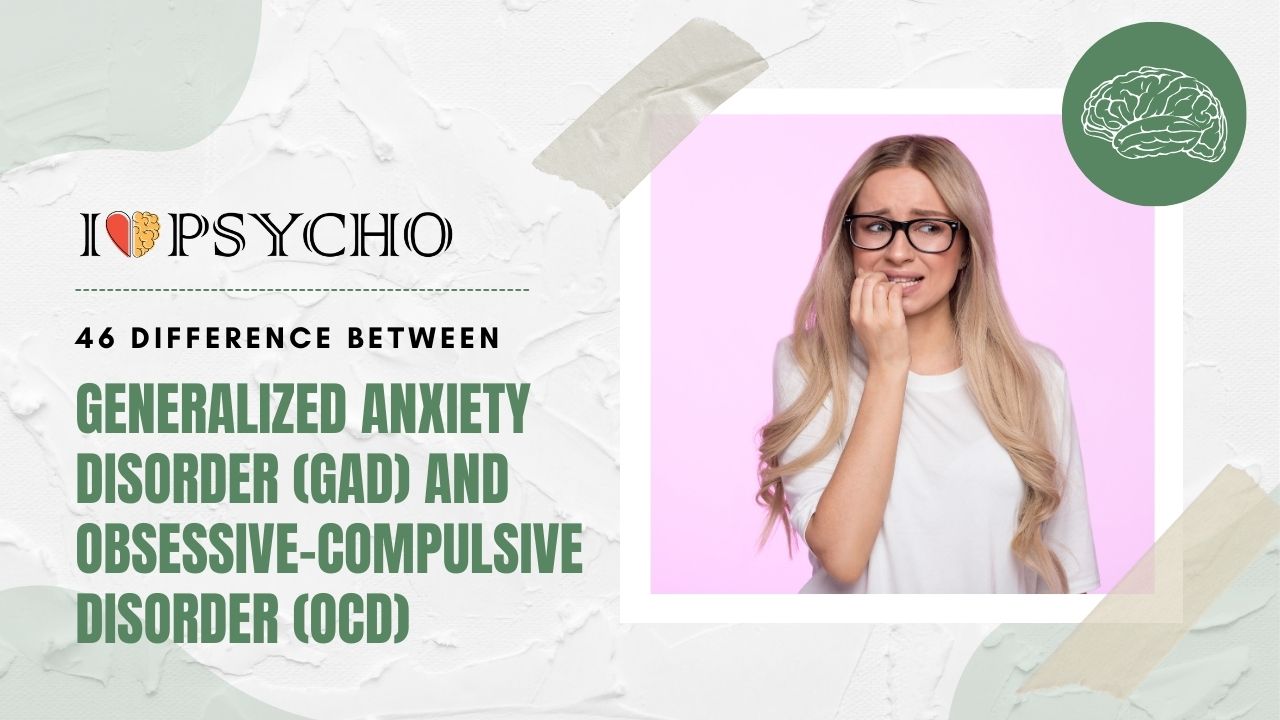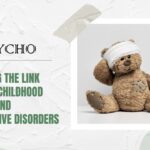OCD and GAD have different symptoms and behaviors. The main symptoms of GAD are excessive worry and anxiety about jobs, relationships, and health. GAD causes restlessness, muscular tension, and exhaustion due to continuous, uncontrollable anxiety. OCD involves obsessions and compulsions. An obsession is a persistent, disturbing idea, picture, or drive. Obsessions can lead to compulsions to reduce stress or avert negative consequences.
GAD and OCD differ in preoccupations and behaviors. Excessive concern in GAD covers several life areas. It may cause free-floating anxiousness. However, OCD is characterized by extremely particular obsessions that vary greatly. Obsessions with contamination, symmetry, or danger are often illogical. Compulsions like hand washing, checking, and counting help OCD sufferers cope with obsessions.
GAD and OCD also affect emotions differently. Apprehension, restlessness, and uneasiness characterize GAD. On edge, GAD sufferers anticipate unfavorable occurrences without a cause. In contrast, OCD causes acute worry or anguish caused by obsessions. OCD compulsions briefly relieve distress, but soon return to repeated behaviors.
According to the DSM-5, GAD and OCD are distinct disorders. Due to comorbidity, people might have both disorders. Adequate diagnosis and classification between GAD and OCD are essential for therapy planning. Both disorders entail anxiety, but their causes, symptoms, and treatments differ. Cognitive-behavioral therapy and anti-anxiety medicines frequently help GAD. In contrast, exposure and response prevention therapy is typically needed to treat OCD’s unique obsessions and compulsions. GAD and OCD are separate mental health illnesses with different symptoms, causes, and treatment techniques, emphasizing the significance of correct diagnosis and specific therapy.
|
S.No. |
Aspect |
GAD |
OCD |
|
1 |
Type of Disorder |
Anxiety Disorder |
Anxiety Disorder |
|
2 |
Primary Symptoms |
Excessive worry and anxiety |
Obsessions and compulsions |
|
3 |
Nature of Worry |
Generalized, not specific |
Focused on specific obsessions |
|
4 |
Trigger Factors |
Often no specific triggers |
Obsessions trigger compulsions |
|
5 |
Time Spent on Symptoms |
Constant throughout the day |
Obsessions and compulsions are time-consuming |
|
6 |
Prevalence |
More common |
Less common |
|
7 |
Age of Onset |
Usually in adulthood |
Often begins in childhood or adolescence |
|
8 |
Core Feature |
Excessive worry |
Obsessions and compulsions |
|
9 |
Cognitive Patterns |
Worry about various life issues |
Intrusive, irrational thoughts |
|
10 |
Physical Symptoms |
Muscle tension, restlessness |
Physical rituals (e.g., hand washing) |
|
11 |
Emotional Symptoms |
Nervousness, restlessness |
Anxiety, guilt, shame |
|
12 |
Social Impact |
Interferes with daily functioning |
May isolate due to rituals |
|
13 |
Specific Fears |
Usually non-specific fears |
Specific obsessional fears |
|
14 |
Comorbidity |
Often co-occurs with other disorders |
Can co-occur with other disorders |
|
15 |
Treatment Approach |
Cognitive Behavioral Therapy (CBT), medication |
CBT, Exposure and Response Prevention (ERP), medication |
|
16 |
Medication Types |
Antidepressants, anti-anxiety meds |
Antidepressants, sometimes anti-psychotics |
|
17 |
Goal of Treatment |
Reduce excessive worry |
Reduce obsessions and compulsions |
|
18 |
Prognosis |
Generally manageable with treatment |
Variable, may be more chronic |
|
19 |
Safety Behaviors |
Often no specific safety behaviors |
Often involves specific rituals |
|
20 |
Intrusiveness of Thoughts |
Thoughts not necessarily intrusive |
Thoughts highly intrusive |
|
21 |
Ritualistic Behavior |
Rarely involves rituals |
Central to the disorder |
|
22 |
Fear of Consequences |
Concerned about real-life consequences |
Fear of imagined consequences |
|
23 |
Insight |
Usually maintains insight into irrationality |
Varies; some have insight, others do not |
|
24 |
Perfectionism |
May have perfectionistic tendencies |
Often exhibits perfectionism |
|
25 |
Recurrence |
Chronic but may have periods of improvement |
Chronic, often lifelong condition |
|
26 |
Awareness of Symptoms |
Aware of excessive worrying |
Aware of obsessions and compulsions |
|
27 |
Control over Symptoms |
Limited control over worry |
Limited control over obsessions/compulsions |
|
28 |
Thought Content |
Varied, often about life stressors |
Repetitive and specific thoughts |
|
29 |
Response to Triggers |
Worry and anxiety response |
Obsessive thoughts and compulsive actions |
|
30 |
Avoidance Behaviors |
Avoidance of anxiety-provoking situations |
Avoidance related to obsessions |
|
31 |
Relationship Impact |
May strain relationships |
May strain relationships |
|
32 |
Impact on Daily Functioning |
Interferes with daily activities |
Can significantly disrupt daily life |
|
33 |
Need for Reassurance |
Seeks reassurance about general concerns |
Seeks reassurance about obsessions |
|
34 |
Specific Diagnostic Criteria |
Follows criteria specific to GAD |
Follows criteria specific to OCD |
|
35 |
CBT Techniques |
Worry exposure and challenging |
Exposure and response prevention (ERP) |
|
36 |
Diagnostic Tool |
Diagnosed using DSM-5 criteria |
Diagnosed using DSM-5 criteria |
|
37 |
Preoccupation with Thoughts |
Preoccupied with daily life concerns |
Preoccupied with obsessional thoughts |
|
38 |
Coping Mechanisms |
May use avoidance or seeking reassurance |
Rituals as coping mechanisms |
|
39 |
Impact on Sleep |
Often leads to disrupted sleep patterns |
May lead to disrupted sleep patterns |
|
40 |
Secondary Anxiety Symptoms |
May experience panic attacks |
May experience panic attacks |
|
41 |
Family History |
May have a family history of anxiety |
May have a family history of OCD |
|
42 |
Risk of Depression |
At risk of developing depression |
At risk of developing depression |
|
43 |
Duration of Symptoms |
Chronic, with fluctuations in severity |
Chronic, with fluctuations in severity |
|
44 |
Gender Predominance |
Slightly more common in women |
Equal prevalence between genders |
|
45 |
Impact on Self-Esteem |
May lower self-esteem |
May lower self-esteem |
|
46 |
Awareness of Irrationality |
Usually recognizes worry as excessive |
Varies; some recognize irrationality, others do not |
Frequently Asked Questions (FAQs)
Q1: What distinguishes GAD from OCD?
The main difference is their symptoms. GAD involves excessive, generalized worry and anxiety about life, whereas OCD involves particular obsessions and compulsions. GAD worries are general, but OCD obsesses on specific topics.
Q2: Can GAD and OCD coexist?
Comorbidity is the simultaneous presence of GAD and OCD. Each disease may need different treatments, making diagnosis and therapy more complicated.
Q3: How are GAD and OCD emotions different?
Typical symptoms of GAD include anxiety, restlessness, and uneasiness. They may predict bad things without a cause. OCD, however, causes acute worry or anguish caused by obsessions. Compulsions bring momentary respite but repeat behaviors.
Q4: What GAD/OCD treatments are available?
Anti-anxiety medicines and cognitive-behavioral therapy are common GAD treatments. To treat obsessions and compulsions, OCD treatment frequently incorporates exposure and response prevention. OCD can be treated with SSRIs.
Q5: How may GAD be distinguished from regular worry?
Across all areas, GAD entails excessive and chronic concern that is hard to manage. Restlessness and muscular tightness often result. Normal everyday worry is situation-specific and controllable, not interfering with daily life. Intense concern may indicate GAD, so seek expert help.









